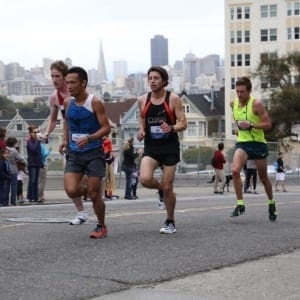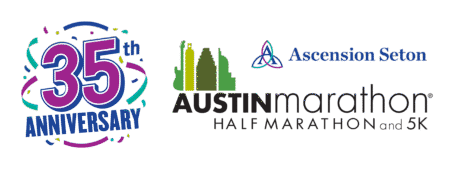An Athlete’s Perspective – Issue 3
An Athlete’s Perspective is a blog series of event and/or training experiences written firsthand by the athlete themselves. An Athlete’s Perspective is a completely unscripted and raw look into the mind and daily life of an athlete as they prepare for their next race. Readers will discover training regimens, eating tips, gear recommendations, and an uncut perspective into the lives of people like you and me.
Putting Trail Running Into Your Marathon Plans
by: Rio Reina

Reina: 2017 Austin Marathon Elite Athlete
When I first started training for the marathon in 2010, I would have not considered adding a high percentage of mileage on the uneven dirt paths. One reason I stuck to roads for training was to hit my certain paces. Another reason was to avoid the challenging terrain and agility that came with it. But most importantly, at the time, I did not fully appreciate the experience of a traverse through a great trail. I had been used to high rhythm running, where I could turn my brain off and just push through an 18-mile road run. Roads fit the rhythm profile, while trail running was more cumbersome. After moving to the Bay Area in October 2016, trail running has been a big part of my training for the Austin Marathon.
In the Bay Area running community, trails are king. And how can you blame them? There are single-track trails with epic views that overlook the Golden Gate Bridge within a 15-20 minute drive of San Francisco. Also, there’s a support of races that explore distances of 50K to 100 miles and running stores with trail training groups. After moving out here, I couldn’t help but put in my miles on the trails and start eyeing ultra trail races as well. I do have passion for the roads still and want to achieve a 26.2 personal best in the Austin Marathon, so I decided to do a hybrid road/trail marathon program. I’d like to share some tips with you.
Here are some of the ways to add trail running into training
Do some long runs on trails, focus on lengthening the duration (total time) and practicing nutrition, forget about mileage
Trails tend to be more technical and challenging than roads, so your pace won’t be the same. This is not a bad thing! This will help more with fat burning and practicing your nutrition plan. If your road long runs are two hours in duration, go for a 2:30 – 3 hour run at an easier effort on the trail. Ensure you have some nutrition and proper hydration. Carry a hand-held or a hydration belt on these runs! I usually low-ball my fuel on these efforts since I’m trying to deplete energy stores, but keep hydration consistent. For 2:30 – 3 hour runs, I’ll take 1-2 gels and 16 -20 ounces of water per hour.
Use elevation to your advantage
In trail running, elevation is a metric that is often discussed. Trail runners would ask, “How much vert was in the race?” In fact, the trail runners thrive on a challenging course, while marathoners tend to want a flatter, faster course. With elevation comes the opportunity to work on different running techniques that will help your overall fitness. With long uphills, I tend to find much more stress on my oxygen intake. Long uphills, even at a moderate pace, start to stress the system aerobically like a tempo run. With the downhill, I practice high turnover and efficient landing. I try to not stomp or brake on downhills, as running downhill is a skill itself, so I try not to disrupt the free energy! My advice is to say yes to hilly trail runs!
Recover on trails
Steve Sisson, coach of Team Rogue, used to tell us, “Hit the Greenbelt! The muscles get a different workout!” I try to take my recovery runs into trails mainly to give my body a change in surface. I feel like it helps combat overuse injuries by making you change your running mechanics and softening up the impact. Trail running tends to need more agility as well, so the stride is not as linear as road running. While road running takes a toll on quads and calves, trail running tends to use more mobility in the ankles and hips. I would advise recovery runs on trails after hitting a challenging workout on the road.
Sign up for a trail race!!
I did my first ultra in December at the Woodside Ramble 50K, which was a blast! I enjoyed the race and thought it was a great effort for my first off-road event. The Inside Trail team put on a great event and the trail community is very welcoming. I placed 2nd in 3:42 after running in first for 24 miles; I hit the wall and was passed. I learned a lesson about how trail racing is about patience, fueling, and pacing. The overall benefit from doing this race was that it was a great fitness boost and helped teach my body to burn fat more efficiently. Also, it allowed me to run further than 26.2 miles, which was the first time in my career. To top it all off, the softer trails were much more forgiving than roads, so my legs were recovered within 2-3 days. My advice would be to sign up for a trail race, 30-35K are great and for those looking for a greater distance challenge, look into 50Ks. They are a fun way to meet new people and break up the monotony of training!

Reina (blue top) on the roads.
Keep the pace and road work in the program
Although I do love a run through the woods, I would advise to still keep some faster runs in the program consistently. I do my tempo runs and half my long runs still on roads to keep my pace dialed down. Road running is still a unique stress on the body and needs to be practiced for a road race. Pick certain pace workouts, like a 12-mile marathon-paced run, to do on a road or bike path course. Also, do a few long runs on the roads as well.
Additional Advice from a National Champ
Lastly, I chatted with Jorge Maravillia, two-time USATF Trail Champion and 2:21 marathoner. Jorge’s advice was that he feels like there’s value that is transferable from trail to road racing. His points were that speed work from road racing tends to help with form while running trails. As for trails, the grit and patience tends to play nicely into marathon training, especially when you are out there for hours. He tends to say road racing is about chasing splits and pushing the pace, while running trails is about enjoying the experience and scenery as you push yourself. They are different, but he enjoys the challenges in both!

 Replace electrolytes
Replace electrolytes


